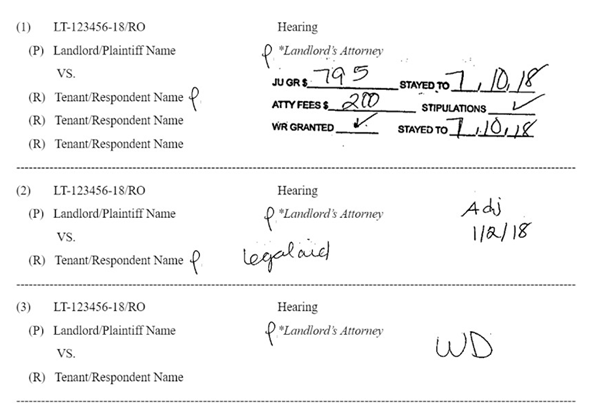Bethany Tallis
What is our Data?
Throughout 2017, the Rochester City Court heard approximately 8,000 trials between landlords and tenants. Our data is a random, and thus representative, sample of 718 of these cases.
When a Tenant is called to court, their case is displayed on the Civil Calendar on the day prior to their hearing. A sample of what this looks like is as follows:

The judge, deputies and attorneys each receive a copy of the civil calendar for the day, and one of the court clerks transcribes the judge’s decisions onto a copy of the calendar; it is this completed calendar which we have used to collect the data for 2017 hearings. Some common calendar markings are displayed below, representing several possible outcomes within Landlord Tenant Court:

Case (1): Shows an outcome where a judgement and warrant was granted, with identical ‘stayed to’ dates. Both the landlord’s/petitioner’s attorney and one tenant/respondent was present at court. Both stipulations and attorney’s fees were assigned to this case.
Case (2): Shows an adjournment to January 2nd. Both the landlord’s/petitioner’s attorney and tenant/respondent were present, with the tenant being represented by a legal aid attorney.
Case(3): Shows a withdrawn case, with only the landlord’s/petitioner’s attorney present.
Variables Recorded in the Data
We recorded the following information about each case:
| Data Collected | Calendar Markings | Description/Additional Info |
| Hearing Time | Hours:Minutes:Seconds Eg. 9:30:01 | When the judge calls the case to the stand, the scribe notes the exact time. A case can be recalled for various reasons, meaning two or more times would be listed on the calendar. |
| Outcome | Withdrawn, Dismissed or Adjourned, Eg. WD, Dism, Adj Judgement amount noted in dollars, Eg. $1000 | If the case was adjourned, the adjourned to date was recorded. The judgement amount is typically determined through negotiations between plaintiff and respondent, and tends to include back rent and any late fees as stated in the lease. |
| Warrant | A check mark indicates if a warrant will be issued | A warrant marked as ‘yes’ in our data means that a warrant of eviction will be issued by the sheriff or other official on the date accompanied. |
| Plaintiffs/Respondents present | A ‘p’ is placed next to the plaintiffs and respondents present in court | “John Doe” and “Jane Doe” represent respondents whose identity is under protection. |
| Attorneys present | A ‘p’ is placed next to attorney’s present in court | If an attorney is not printed on the calendar, the scribe will write it in. |
Limitations of the Data
- The data shows the final outcomes decided in front of a judge. The data does not show reasons for which cases brought in the first place, or reasons for the decisions given.
- The data also fails to show negotiation processes that occur outside of the courtroom, prior to the case being heard
- Our data only represents cases which are brought to court in 2017, and in no way represent evictions that occur outside of the courtroom
Observing Hearings
- Each student attended Landlord Tenant Court for 6 consecutive weeks. During the morning session, each student either shadowed a Legal Aid attorney, a Plaintiff attorney, or witnessed trials in the courtroom.
- In attending court for this period of time, our goal was to better understand the data we were interpreting. Each student witnessed a combination of decisions, negotiations between attorneys, and general interactions inside the courtroom and outside the courtroom
- Weekly visits specifically aided in the understanding of several process’, such as:
- Negotiations outside the courtroom
- Impact of different judges on case outcomes
- Reasons behind certain outcomes in court
- Larger issues associated with Landlord Tenant Court
Additional Notes
- We listed the first and second petitioners in the corresponding columns, but listed other plaintiffs in the notes section. We estimate that this occurred in less than 1% of cases.
- For marking parties who were present, a ‘P’ is typically used. In some cases, an ‘X’ was used to denote parties who were not in attendance. We estimate that this occurred in less than 1% of cases.
- Hearing times are sometimes recorded with no seconds value and an “ish” instead, as in “10:30ish”. In these cases, we recorded the hearing time seconds as “00”. For instance, we recorded “10:30ish” as “10:30:00”. We estimate that this occurred in less than 1% of cases
- Hearing times sometimes omitted a seconds value, as in “10:30”. In these cases we recorded seconds as “00”. For instance, we recorded “10:30” and “10:30:00”. We estimate this occurred in less than 1% of cases
- For cases that were recalled, we noted the latest time on the file as the Hearing Time. Previously called times were placed in the “Notes” section of our data.
Acknowledgements
- We would like to thank the LASROC attorneys and staff, specifically Mark Muoio, Lauren Pienkowski, Michael Furlano, and Ariel Cruz for allowing us to shadow them, providing guidance, and for supporting our work.
- We would also like to thank Erin Elsner, for allowing students to shadow her in court, aiding our understanding of the plaintiffs attorney point of view.
- Finally, we would like to extend a large thank you to Clerk of the Court Gene Crimi and his staff as well as Mark Muoio for their detailed input, constant support and guidance throughout the entire data analysis and court proceedings process.